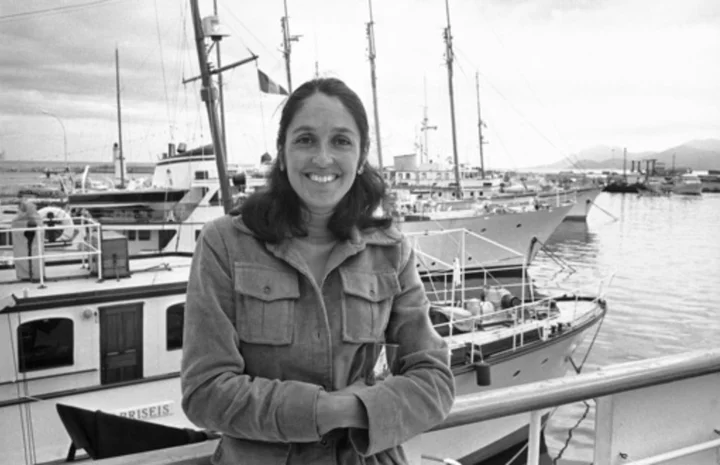Bob Dylan called it her “heart-stopping soprano,” and it’s true that when Joan Baez unleashed that pure, angelic voice on the protest song “We Shall Overcome,” you could believe we would, indeed, overcome.
The celebrated folk singer and activist was singing about civil rights, of course. But what we learn in the thoughtful, thorough and sometimes harrowingly intimate “Joan Baez: I Am a Noise” is that Baez was also seeking to overcome much on a personal scale: anxiety, depression, loneliness and, late in life, troubling repressed memories about her own father.
If that sounds like a lot to cover in 113 minutes, it is — especially because the new documentary, directed by Maeve O’Boyle, Miri Navasky and Karen O’Connor, also recaps a 60-year performing career, with the singer telling her story through interviews and an incredible wealth of archival material. We see Baez entering for the very first time a storage unit filled to the ceiling by her late mother with photos, home films, audio recordings, letters, drawings and even tapes of therapy sessions.
And she gave her directors the key. The film was originally intended simply to cover Baez's last, 2018 “Fare Thee Well” tour, but Baez decided to leave a more thorough legacy.
The film begins with novelist Gabriel Garcia Marquez's quote about how everyone has three lives: public, private and secret. Well, this is certainly apt for Baez, who emerged as a sudden star in 1959, an 18-year-old with a guitar and that bell-like voice, and went on to make some 40 albums, with a 2017 induction into the Rock & Roll Hall of Fame. As we see from her own anguished drawings and letters beginning in youth, her intensely public life masked both a difficult private one and some dark secrets as well.
And then there was Dylan, the same age as Baez, that inscrutable genius who stole her heart and then broke it. It was intoxicating being together, recounts Baez, who introduced him lovingly to her audiences, until a painful UK tour when his fame blossomed and "it was horrible.” Then, staring into the camera, she says: “Hi, Bob!” It’s a welcome and rare opportunity to laugh with her.
But back to the beginning, where Baez, on the cusp of 80, is preparing for the tour, rehearsing at home in northern California. Her hair is fully gray; her face has not changed much. “I know I look good for my age, but there is a limit,” she quips of upcoming retirement. As for her voice, it’s there, but definitely lower and more ragged.
Amid concert footage, we toggle to scenes of Baez's youth. We also hear, on and off, a strange (and rather distracting) male voice sounding like a hypnotist. It turns out to be her therapist.
The story begins with lovely, black-and-white footage of Joan as a child, dancing in a field with her parents and sisters. Her Mexican-born father was dashing. The scenes look idyllic, but there are signs of trouble ahead when, in an interview from the present, Joan notes mysteriously: “I’m way too conflicted to just have a bunch of happy memories.”
We see pages from young Joan’s journal, its copious sketches brought to life by wonderfully inventive animation, and hear how white kids called her “the dumb Mexican” in school. Panic attacks and anxiety set in. Even when she becomes a star, breaking out at the Newport Folk Festival in 1959, her self-image doesn't seem to thrive. Nestled among the many letters to her parents is a drawing of a very small girl: “This is how I felt on the Carnegie Hall stage.”
And then a charismatic singer-songwriter invades her life.
”I was just stoned on that talent,” she says of Dylan. One of the best moments of the film has Baez at the mic, during good times, imitating Dylan imitating her.
But later, on that tour to Britain, he leaves her in his wake. “Dylan broke my heart,” she says.
A new phase sees Baez deeply engaged in protests against the Vietnam War – even going to jail. There, young activist David Harris visits her. The two will marry, she'll become pregnant, and then HE will go to jail. When he comes out, the marriage is troubled and doesn’t last. “He was too young and I was too crazy,” she says. Gabriel, her son, plays drums in his mother’s band on the farewell tour.
Later scenes have Baez discussing a phase of reliance on Quaaludes, which cause her to make some questionable decisions, including posing for an album cover in huge aviator goggles.
The final act deals with accusations against her father of inappropriate sexual behavior with Joan and one of her sisters, Mimi. Her parents, both deceased, denied it, and Joan’s own memories lack detail. She has said she could not have told this story while her parents were still alive.
There's an excruciating tape of a phone message from her accused dad, and then a tender scene where Baez comforts her aging and dying mother.
And then, after footage of a final concert at New York’s Beacon Theater, we see the now-retired Baez dancing in a field near her home. A nod perhaps to the childhood scenes — but also maybe a statement that while she hasn’t overcome it all, she’s overcome a heckuva lot.
“Joan Baez: I Am a Noise,” a Magnolia Pictures release, is unrated by the Motion Picture Association. Running time: 113 minutes. Three stars out of four.

